Call queues are beneficial to managing high call volume. They organize agents into groups (and optional tiers) to streamline the flow of incoming calls. Callers also benefit; through the use of music on hold and announcements, the caller is comforted
Types of Call Queues
Round-Robin (longest idle) routes callers to the agent who has been idle longest.
Tiered Round-Robin routes callers to tiers of agents, who are then rung one at a time before the caller moves to the next tier, until an agent answers.
Ring All routes callers to all available agents at the same time.
Linear Hunt routes callers to the available agents in a pre-defined order.
Linear Cascade routes callers to groups of available agents in a pre-defined order.
Call Park places the caller on hold until an agent retrieves the call.
Call Queue Behavior
Call queues are typically straight forward. Callers are routed based on the type of queue they've entered and how that queue has been configured. Agents then receive the call based again on the queue's configuration, but also on their own personal status, priority, and the number of concurrent calls allowed.
There are certain behaviors that result from seemingly simple actions. This section describes what to expect for specific, complex queue configurations.
Receive a Callback - Unlimited Queue Timeout
Situation: The "queue timeout" has been set to "unlimited". How does callback function?
Technical Explanation: When the queue timeout is unlimited, there are two ways to be prompted for the call back option:
- If a queue has been configured to require agents (Require Agent=yes), and no agent is available, then the caller will hear the prompt to leave a voicemail, wait for a callback, or enter the queue. This prompt happens under this circumstance regardless if the queue timeout has been set to "unlimited" or not.
- The caller can press 0 to escape from a queue while they are listening to the MOH. They will be prompted with the same choices as above: leave a voicemail, wait for a callback, or return to the queue.
Both of these scenarios can also be affected by the configured "unanswered" treatment. This treatment takes precedence even when an unlimited queue timeout has been selected.
Stay in Queue w/ Ring timeout
Situation: The queue's "unanswered" treatment has been configured to "stay in queue" AND there is a configured ring timeout as well. What will happen; will callers stay in the queue?
Technical Explanation: As with all of the advanced queue configurations, there is some ambiguity here.
- First of all, the "stay in queue" treatment disables the ForwardNoAnswer for the queue owner. ForwardNoAnswer is set when the "Unanswered Treament" is NOT "Stay in Queue". So the caller will be prompted for the usual options: leave a voicemail, wait for a callback, or stay in the queue.
- When the call hits the configured ring timeout, the caller is not immediately disconnected. The "if unanswered: stay in queue" treatment will then prompt the user for the same options to leave a voicemail, wait for a callback, or stay in the queue.

Getting Started
Call Queue Rules
1. Users with the scope of Office Manager and above can add and configure call queues. Call Center Supervisors cannot add or delete a call queue, but they can change the type of queue assigned to a particular extension and pre queue / in queue / SMS options. Refer to the User Manual or more information.
2. A call queue must have a dedicated extension and owner. If the extension you are creating for the queue is not currently present then the system will create one and indicate this by showing the green New label to the right of the dialog box.
3. If the call queue does not have a music on hold file, then the system will default to using the domain music on hold.
Agent Rules
1. A call queue must be configured first before assigning an agent and the agent must be "online" in order to be part of an active queue.
2. Call queues can contain both on-net and off-net agents.
3. If a device is not registered, then the agent is considered "offline".
4. Agents who are assigned to multiple queues can prioritize one queue over another.
Configure a Call Queue
This tab explains how to create a new call queue, including the different options based on type of call queue, and how to configure an "exit" option for clients inside of a call queue.
1. With the scope of an Office Manager or above, navigate to the Call Queue screen within a domain.

2. This screen lists all of the available call queues under the logged-in user's domain. Configured call queues can be edited here, and new call queues can be created.
Add/Edit a Call Queue
There are 4 available tabs in the Add Call Queue modal and also while actively editing an existing call queue: basic, pre queue options, in queue options, and SMS. Fill out the fields as needed and then click Save to save the new call queue.
Basic Tab
The first tab sets the name and extension of a call queue (which is required). "Name" can later be changed, but the extension cannot.
Call Park Info
Call Park is the only call queue type that does not have any tab beyond the Basic tab, and it also does not have any of the configuration options listed below Type.
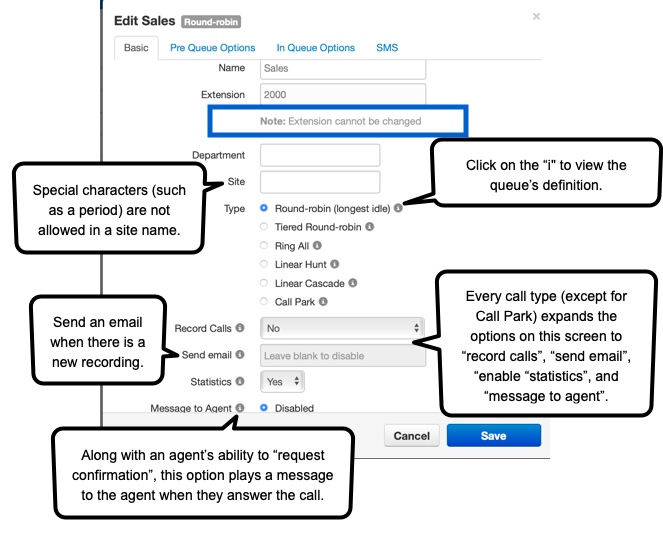
Pre Queue Options Tab
This screen has the same choices regardless of which call queue type is selected (except for Call Park, which does not have any additional tabs beyond Basic).
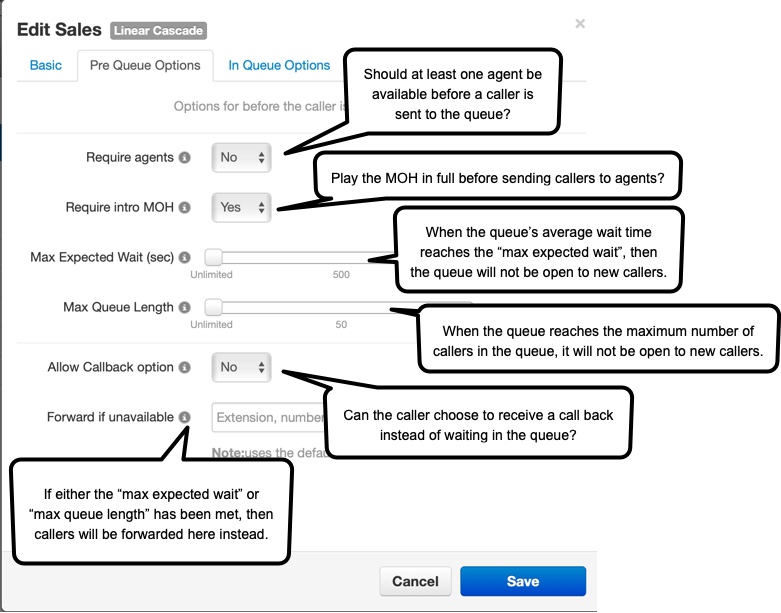
Forward if unavailable
If no agents are available when a caller rings in, and the "require agents" dropdown is set to "yes", then the caller will route to the "forward if unavailable" entry as expected.
In Queue Options Tab
This tab configures what happens to callers while they are in the queue waiting to be directed to an agent.
These are the in queue options available for the following call queue types: Round-robin, Tiered Round-robin, and Linear Hunt.
Logout Agent on Missed Call
Note that "logout agent on missed call" will not work as expected if the call queue is managed by "User" vs. managed by "Device".
If, for example, a user has simultaneous ring set-up, the call queue won't know if the agent actually missed the call and therefore won't log them out.
If the queue is set to the user's device, then the queue can determine if the call was missed on the specified device, and works as expected.
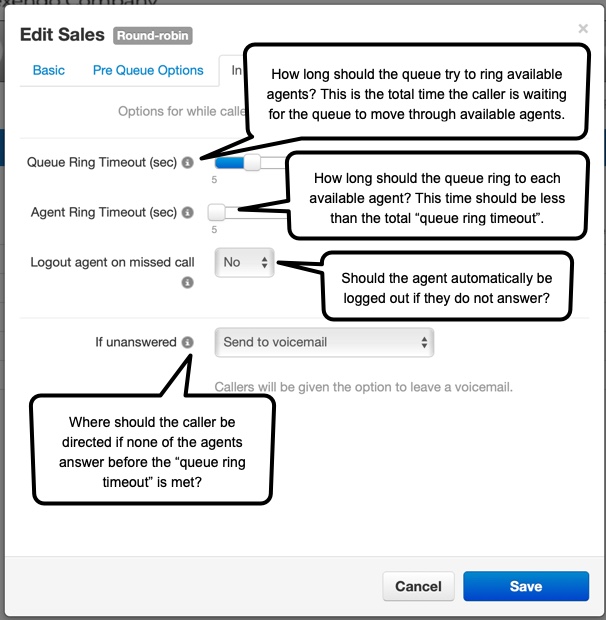
Queue Ring Timeout Info
Queue Ring Timeout when set to Unlimited in any queue type will mirror the MaxTalkDuration value, which defaults at 7200s.
Callers will be sent to the queue's voicemail if agents fail to answer before the Ring Timeout and if Forward if unanswered is not set. This will also trigger the system message: “Please continue to hold or Press 2 to leave a voicemail” and then return the call back to the queue if nothing is pressed. The voicemail box for the option to Press 2 is the call queue owner's voicemail box.
These are the in queue options for only the Ring All call queue type.
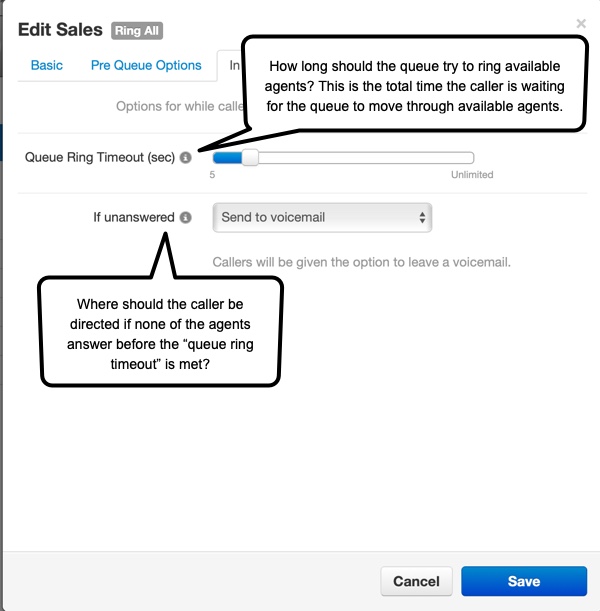
These are the in queue options for only the Linear Cascade call queue type.
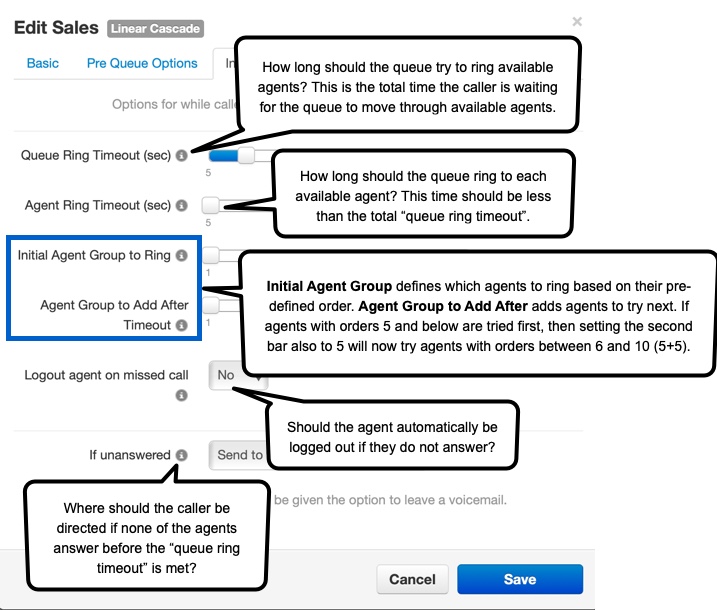
SMS Tab
This screen has the same choices regardless of which call queue type is selected (except for Call Park, which does not have any additional tabs beyond Basic).
Enabling SMS opens the following configuration options:
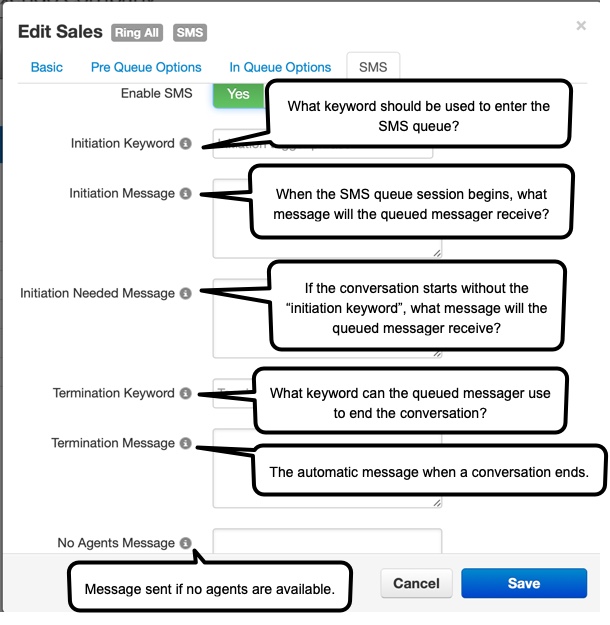
Exiting a Call Queue
Call queues can be configured to allow callers to exit a call queue at any time* of their choosing, or to forward themselves to another service or voicemail by pressing 0
*Note that callers cannot exit a call queue via the escape method if the call is in a dispatching state. They can only exit the call queue when the call is in a held state.
1. Caller can enter 0 during the hold music to exit to the "forward no answer" option.
2. If a "forward no answer" option is not configured, then at timeout, the caller will be automatically prompted to leave a message or continue waiting.
